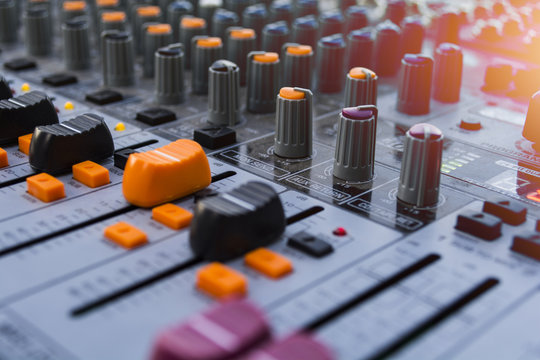Are you looking to break into the world of music production? If so, you’ll need to understand the essential elements of music production. In this guide, we’ll take a deep dive into the world of music production, exploring the elements that make up the process. From understanding the different types of music production techniques to knowing the right recording equipment and software to use for different genres, this guide will provide you with a comprehensive overview of the elements of music production. Let’s get started!
Table of Contents

Understanding Music Production
Music production is a multi-step process that involves creating, arranging, and recording music. It requires a deep understanding of music theory, as well as technical skills in recording, editing, mixing, and mastering.
Overview of Music Production Process
The music production process begins with songwriting, where the composer creates the melody and lyrics. Once the song is written, the producer arranges the music to create a structure and mood that complements the lyrics. Next, the music is recorded, edited, mixed, and mastered to create a polished final product.
Different Types of Music Production
There are two primary types of music production: electronic and acoustic. Electronic music production involves the use of electronic instruments such as synthesizers and drum machines, while acoustic music production involves the use of instruments such as guitars and pianos. Each type of production requires a unique set of skills and equipment.
Key Components of Music Production
The key components of music production include songwriting, arranging, recording, editing, mixing, and mastering. Songwriting involves creating the melody and lyrics, while arranging involves structuring the music to complement the lyrics. Recording involves capturing the sound of the instruments and vocals, while editing involves cutting and splicing the recorded tracks. Mixing involves balancing the levels of the instruments and vocals, while mastering involves finalizing the mix to ensure that it is consistent and polished.
Role of Music Producer
The role of a music producer is to oversee the entire music production process. They work with artists to create and develop songs, select the right equipment and software, oversee the recording and editing process, and work with audio engineers to ensure that the final product is of high quality. A good producer has a deep understanding of music theory, technical skills in recording and editing, and the ability to communicate effectively with artists and engineers.
Music Production Techniques
Music production techniques are the methods used to create and arrange music. These techniques are applied to different components of music such as melody, rhythm, and harmony to create a unique musical composition. There are various types of music production techniques, including sampling, layering, and effects processing. The key to using these techniques effectively is knowing when and how to use them.
Sampling
Sampling involves taking a small portion of an existing sound recording and incorporating it into a new composition. This technique can add unique textures and sounds to a recording, but it’s important to ensure that the samples are properly cleared and licensed to avoid legal issues. Sampling is commonly used in genres such as hip-hop, electronic, and pop music to create new and innovative sounds.
Layering
Layering involves combining multiple sounds to create a complex sound. This technique can create a more full and dynamic sound, but it’s important to be careful not to overdo it and create a cluttered mix. Layering is often used in genres such as rock, heavy metal, and orchestral music to create a powerful and impactful sound.
Effects Processing
Effects processing involves using effects such as reverb, delay, and compression to enhance the sound of a recording. These effects can greatly improve the overall sound of a recording, but it’s important to use them judiciously and in a way that complements the overall mix. Effects processing is commonly used in genres such as electronic, pop, and alternative music to create unique and atmospheric sounds.
It is important to use the right technique for the right genre. For example, sampling and layering are commonly used in hip-hop and electronic music, while acoustic music often uses live recording techniques. It’s also important to consider the overall style and mood of the composition when choosing which techniques to use. A careful and thoughtful approach to music production techniques can help create a polished and professional final product.

Recording Equipment and Software
Recording equipment and software are essential components of music production. They play a crucial role in capturing, editing, and manipulating sound to achieve the desired outcome. In this section, we will discuss the different types of recording equipment and software used in music production.
Microphones
Microphones are used to capture sound in music production. They come in different types, including condenser microphones and dynamic microphones. Each microphone type has its own unique characteristics, and choosing the right one is crucial for achieving the desired sound. For instance, dynamic microphones are ideal for capturing the punch and power of drums, while condenser microphones are better suited for capturing the nuances of acoustic guitars and other stringed instruments.
Audio Interfaces
Audio interfaces are used to connect microphones and other instruments to a computer for recording. They play a vital role in ensuring high-quality recordings by providing high-quality preamps and converters. Audio interfaces come in various types and configurations, including USB, Firewire, and Thunderbolt. Choosing the right audio interface is essential for achieving a clean and polished sound.
Digital Audio Workstations (DAWs)
DAWs are software programs used for recording, editing, and mixing music. They provide a virtual recording studio that allows producers to create and manipulate sound using a computer. There are various types of DAWs available, including Ableton Live, Logic Pro, and Pro Tools. Each DAW has its own unique features and capabilities, and choosing the right one is essential for achieving the desired sound.
It is crucial to choose the right equipment and software for the right genre. For example, a condenser microphone may be ideal for capturing the nuances of an acoustic guitar, while a dynamic microphone may be better suited for recording drums and other percussion instruments. Similarly, different DAWs may be better suited for specific genres, such as Ableton Live for electronic music and Logic Pro for pop and rock music.

Audio Mixing and Mastering
Audio mixing and mastering are the final stages of music production, where the individual tracks are blended together into a cohesive and polished final mix. Mixing involves adjusting the levels, panning, EQ, compression, and other effects to create a balanced sound. Mastering is the final step that involves preparing the final mix for distribution by adjusting levels, EQ, compression, and other effects to ensure the mix sounds consistent across all playback systems.
EQing
Equalization (EQ) is the process of adjusting the balance of frequencies in a recording to improve the overall sound. This can involve boosting or cutting certain frequencies to add or remove certain sounds, or to create a more balanced mix overall. It is important to use EQ judiciously to avoid muddying the mix or creating harsh, unnatural sounds.
Compression
Compression is a technique that reduces the dynamic range of a recording by compressing the loudest parts and boosting the quieter parts. This can help to create a more consistent and polished sound, but it’s important to use compression judiciously to avoid losing the natural dynamics of the recording. Heavy use of compression is common in electronic music, while acoustic music often uses minimal compression.
Stereo Imaging
Stereo imaging involves adjusting the placement and width of sounds within the stereo field to create a more immersive and dynamic sound. This can involve panning sounds left or right, or using techniques like stereo widening to create a more spacious sound. It’s important to use stereo imaging techniques carefully to avoid creating a cluttered or unnatural sound.
Different types of audio mixing and mastering techniques are used for different genres. For example, a heavy use of compression and stereo effects is common in electronic and hip-hop music, while acoustic music often uses minimal compression and more natural-sounding stereo imaging.

Music Composition and Arrangement
Music composition and arrangement are essential components of music production. Composition involves creating the melody and harmony of a song, while arrangement involves deciding how the various parts of a song fit together.
Composition Techniques
Composition techniques include chord progressions, melodies, and orchestration. Chord progressions are a series of chords used to create musical phrases. Melodies are the main themes of a song, often created using scales, intervals, and arpeggios. Orchestration involves deciding which instruments or sounds are used in a song, and how they are used.
It is important to use the right composition techniques for the right genre. For example, hip-hop often uses simple chord progressions, while jazz often uses complex chord progressions. Electronic music often uses unique and experimental melodies, while pop music often uses catchy and memorable melodies.
Arrangement Techniques
Arrangement techniques involve deciding how the different parts of a song fit together to create a cohesive and engaging final product. It includes decisions about the order of sections, the instrumentation, and the overall sound of the song.
It is important to use the right arrangement techniques for the right genre. For example, pop music often uses a verse-chorus-bridge structure, while electronic music often uses repeating sections with gradual changes. Jazz often involves improvisation and solo sections, while classical music often involves complex arrangements with many instruments.
Examples of Successful Music Composition and Arrangement
Successful music composition and arrangement in different genres include the use of simple chord progressions in hip-hop, and the use of complex chord progressions in jazz. Electronic music often uses unique and experimental melodies, while pop music often uses catchy and memorable melodies. Country music often features storytelling through lyrics and simple chord progressions, while classical music often features complex orchestration and intricate melodies.
By understanding the different composition and arrangement techniques used in various genres, music producers can create unique and memorable songs that resonate with their audience.

The Impact of Music Production Techniques on Sound
Music production techniques can greatly impact the final product of a recording. Here are some examples of how specific techniques can affect the sound of a recording:
Sampling
Using samples can add unique textures and sounds to a recording. However, it’s important to ensure that the samples are properly cleared and licensed to avoid legal issues. When used correctly, samples can add a creative and unique touch to a recording, but overusing them can lead to a lack of originality.
Layering
Layering multiple sounds can create a more complex and full sound. However, it’s important to be careful not to overdo it and create a cluttered mix. Layering can be particularly effective when used to highlight specific elements of a recording, such as a guitar solo or vocal harmony.
Effects Processing
Using effects like reverb, delay, and compression can greatly enhance the sound of a recording. However, it’s important to use them judiciously and in a way that complements the overall mix. Overuse of effects can create a muddy and indistinct mix, while subtle use of effects can add depth and dimension to a recording.

Insider Tips for Music Production
Successful music production requires not only technical knowledge but also creativity and innovation. To help you improve your music production skills, we’ve gathered some insider tips from experienced music producers:
Pay attention to the quality of your recording environment
The recording environment can greatly impact the sound quality of your final product. Consider factors such as room acoustics, background noise, and microphone placement to ensure that you capture the best possible sound.
Take breaks often
Listening to the same sound for extended periods can cause ear fatigue and affect your ability to make accurate judgments about your mix. Take regular breaks to give your ears a rest and come back to your work with fresh ears.
Use reference tracks
Comparing your mix to other songs in the same genre can help ensure that it sounds consistent and competitive. Use reference tracks as a guide for achieving the right levels, EQ, and overall tonal balance in your mix.
Don’t be afraid to experiment
Music production is a creative process, so don’t be afraid to try out different techniques and sounds to find what works best for you. Experimentation can lead to new and unique sounds that set your music apart.
Collaborate with others
Working with other music producers, musicians, or songwriters can bring new ideas and perspectives to your work. Collaborating with others can lead to new and unexpected creative breakthroughs, and help you grow as a producer.
The Future of Music Production
As technology continues to advance, the future of music production is looking brighter than ever. Here are some emerging trends and developments in the industry:
Artificial Intelligence and Machine Learning
Artificial intelligence and machine learning are revolutionizing the way we create and produce music. These technologies are being used to create new sounds, automate repetitive tasks, and help producers work more efficiently. For example, AI can analyze and categorize sounds, generate new sounds, and even suggest musical arrangements.
Virtual Reality and Augmented Reality
Virtual reality and augmented reality are also being explored as new ways for musicians and producers to interact with and manipulate sound. VR/AR technology can create immersive music production environments, allowing producers to experiment with new sounds and techniques in a virtual space.
Streaming and Online Platforms
The rise of streaming and online music platforms is changing the way music is produced and distributed. With more people consuming music digitally, producers are placing a greater emphasis on creating music that is easily consumable on these platforms. This has led to the rise of new genres and styles of music, as well as new opportunities for producers to reach audiences all over the world.
Conclusion
To summarize, music production is a creative and complex process that involves several key components, including songwriting, arranging, recording, editing, mixing, and mastering. By understanding the different types of music production, the techniques and strategies used in music production, and the equipment and software required to produce high-quality music, anyone can become a successful music producer.
It’s important to keep learning and growing in the field of music production. By implementing the tips and best practices discussed in this article, you can improve your skills and create high-quality music that stands out in the industry.
If you’re passionate about music production, be sure to check out our other content for more tips, tricks, and insights into the world of music production.
Common Questions
Who needs to understand the elements of music production?
Anyone interested in creating or producing music.
What are the key components of music production?
Songwriting, arranging, recording, editing, mixing, and mastering.
How do music production techniques impact the sound of a recording?
Techniques like sampling, layering, and effects processing can greatly impact the final product.
Who oversees the music production process?
A music producer is responsible for overseeing the process.
What equipment is needed for music production?
Microphones, audio interfaces, and DAWs are essential for high-quality recordings.
How can I improve my music production skills?
Experiment with different techniques, collaborate with others, and use reference tracks.

